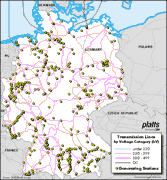National Energy Grid
|
 |
|
Full Size Map National Electricity Transmission Grid of Germany(30 kb) |
GRID SUMMARY
Germany has Europe's largest electricity market. In 2001, Germany generated 544.8 billion kilowatt hours (bkwh) of electricity, two-thirds of which came from fossil fuels (mostly coal), with the other third coming mostly from nuclear power along with small amounts of hydropower and other renewable sources (see graph). Although Germany produces more electricity than it consumes, the country is a small net electricity importer, because of transmission losses and its proximity to foreign sources of generation. Germany has an installed electric capacity of 114 million kilowatts, which includes considerable excess generation capacity.
Recent German estimates predict 14% growth in electricity consumption between 1999 and 2020. Concurrently, Germany has agreed to phase out nuclear power over the next two decades. Nuclear power, which currently accounts for almost one-third of the county's electricity generation, is likely to be replaced by a combination of gas-fired and coal-fired electricity as well as renewable energy. The consumption of renewable energy (including geothermal, solar, wind, wood and waste electric power), has increased dramatically since 1991. The consumption of renewable electricity, particularly wind power, has more than quadrupled since 1991, to 22.6 billion kilowatt hours in 2001, representing approximately 4% of the country's total electricity consumption. Electricity imports, which also could rise in coming years, come primarily from France, the Czech Republic, Norway, and Austria. Germany also exports small amounts of electricity to the Netherlands, Switzerland, and Austria, and in 2000 imports and exports almost completely offset each other.